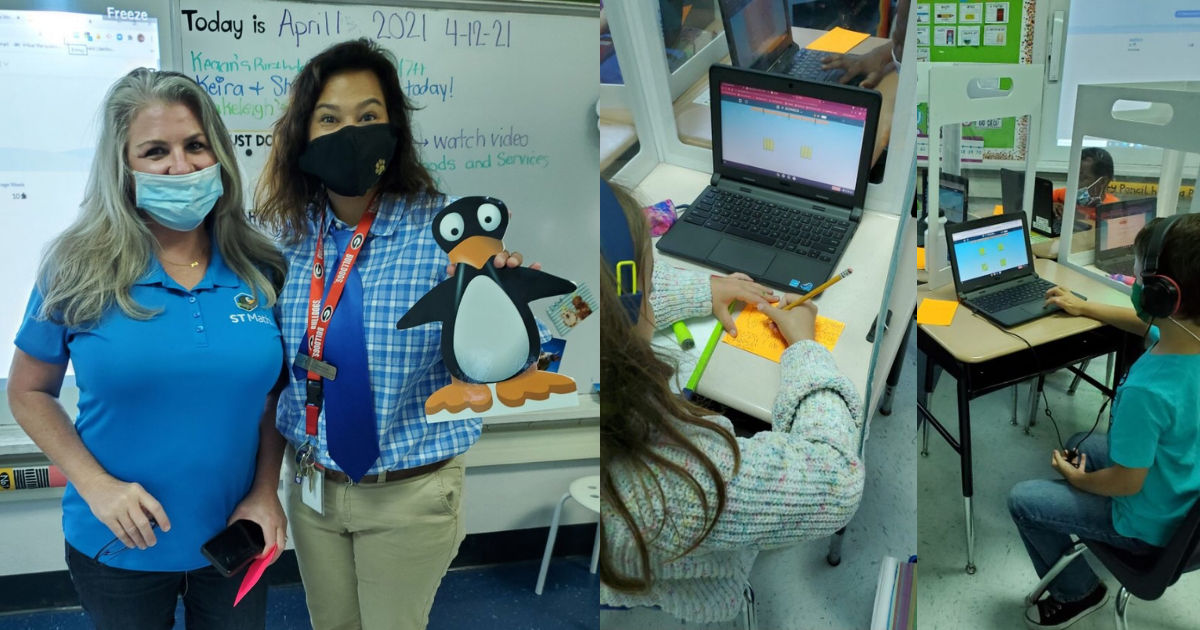
Excited about starting ST Math with your students but don’t know where to begin? That was me last year! I still consider myself an “ST Math Newbie,” and my new students this year are just getting started with ST Math too. Based on my experience so far, I’d like to share what worked well, what my students thought about ST Math, lessons learned, and my future plans for implementation.

Introducing ST Math was all about finding a creative way to spark interest in problem-solving. I found my students are most interested in video gaming, so my approach was to put them in the driver’s seat and let them explore.
Before this, I laid the foundation of “Welcoming JiJi,” the penguin mascot of ST Math. I guided them through the fundamentals of signing on, assigned them roles as “researchers” for ST Math, and set expectations of how to summarize and communicate what we learned, what we liked, and what we didn’t. Students were given choice and voice, making this a student-centered approach.
The next steps were to generate more purpose and guidance as students explored the program. I did this by keeping everything the same from day one, but altered their mission slightly by assigning a new lesson. My goal was to get feedback about how they felt before and after completing an assignment. I needed to understand how they responded with more intentional learning.
I assigned each student a lesson to complete and purposefully made this lesson or assignment a concept that had already been taught. Some students excelled at this while others were not able to complete it. That was OK! At the end of our ST Math session, the students were expected to, once again, provide feedback based on their experiences in completing the assignment. In my opinion, letting students have a voice in their learning makes it much more meaningful.
Once again, I took the feedback of what I learned from observing my students to move forward in understanding how I could keep implementing the approach based on the data I was collecting. In the next session, I gave my students a choice on whether to proceed with their Journey or complete another assignment. While the students worked through the session, I was able to get live data back from the program. I took this opportunity to learn more about how to access student data and the different ways I could use it to differentiate instruction.
As an enthusiast for educational trends, ideas, and programs, I could not help but feel so fired up about ST Math. It’s my mission to take what I know and make it relevant to my students in order to make learning fun for them. What I learned from implementing ST Math was:
Great discussion happening on our #STMathTX teachers panel! pic.twitter.com/g3jIXpBfCi
— ST Math (@STMath) July 27, 2021
Kids say the darndest things! This statement embodies the range of feedback I got from my students. We all have experienced the candid truth of an elementary student. This is one of the characteristics I love about teaching. That being said, asking students for feedback on the ST Math program was the perfect moment to encourage more “voice” in the classroom.
In each ST Math session, I incorporated different avenues of feedback that allowed students to speak, type, write, or draw their thoughts and feelings of their experiences playing ST Math. For example, I added a link to access a FlipGrid, or they could use an index card, or both at the end of the session. Watching and observing the feedback in real time taught me a lot about how ST Math can spark more interest in math!
Later on, I realized that a game-based approach created a new perspective for students about math. This excitement helped them make more connections with the subject matter in new and fun ways. Several of my students could not believe they were doing math and having fun!
Also, feedback was used to guide how I was able to keep implementing the program in the classroom in a more purposeful way. This is why I took it further in creating assignments for students rather than them only playing their Journey.
Finally, my students’ feedback showed that they were more engaged throughout the sessions. Students were intentionally connecting with the program and having conversations with each other to learn more about solving each puzzle. The conversations were helping students develop their academic discourse skills and guided us all in understanding the benefits of using ST Math in the classroom.
As someone who was new to ST Math, I didn’t have any expectations or experience with this program. I chose to implement ST Math as an experiment in order to learn more about a new approach to teaching and learning. I started with baby steps in exploring the program. My students’ connections with JiJi, and their excitement, sparked excitement in me!
Thank you @STMath for giving me the opportunity to share my experience as an STMath newbie! Thank you to all my fellow Educators who joined me today. @S_Consilio @mrs_johansen couldn't do it without y'all! 💓
— Victoria A. Tate (@VictoriaATate1) July 28, 2021
Teachers need to find that spark too. I am still aiming to implement and discover more about ST Math this year. Most importantly, I learned that students and teachers can journey together and learn from each other. ST Math’s “no instructions” approach to learning is a game-changer for kids these days. It creates avenues for students to challenge themselves in using their critical thinking and problem-solving skills.

Victoria Tate is an early childhood education specialist at Fort Sam Houston Independent School District in San Antonio, Texas.
Comment